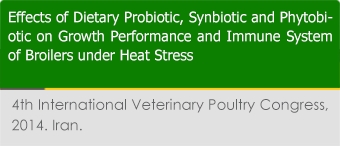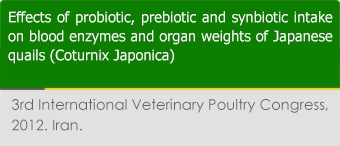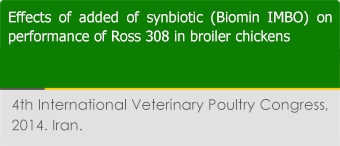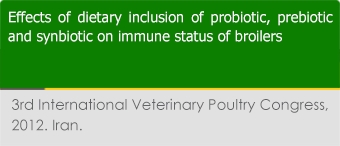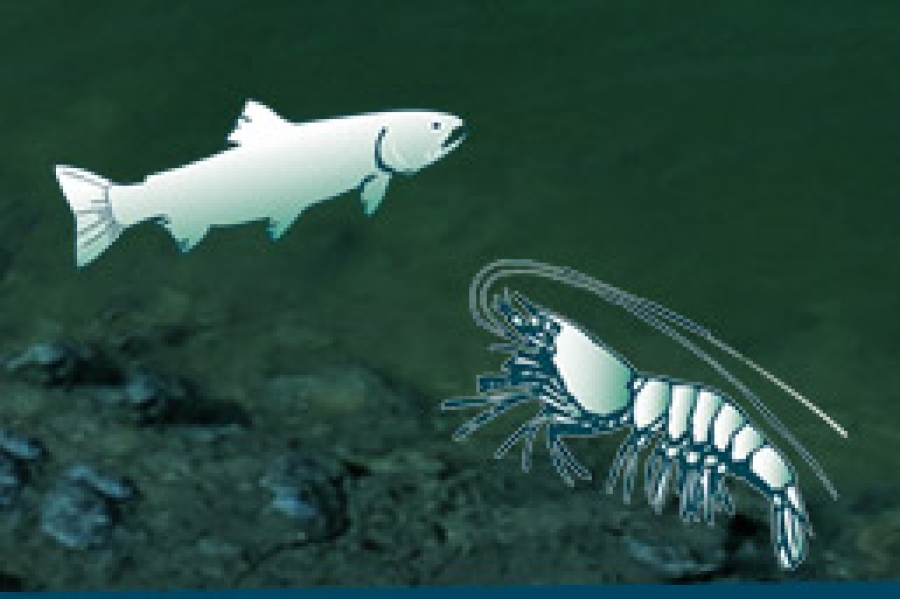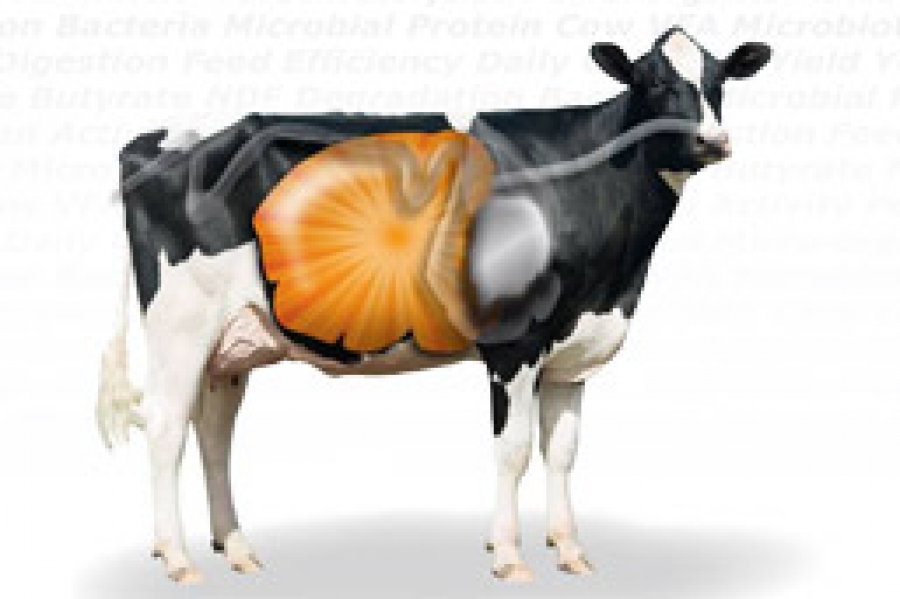
بایومین ایمبو - طیور (14)
T. Steiner, A. Kroismayr, M. Mohnl, R. Nichol, and S. Attamankune
The aim of the trial was to investigate the efcacy of a synbiotic and phytogenic product in comparison to an AGP in broilers. The synbiotic preparation was based on different probiotic strains and fructooligosaccharides (FOS), whereas the phytogenic formula contained a blend of essential oils and FOS. 2400 one-day-old Ross
broiler chicks were assigned to four dietary treatments, comprising 10 replicates per treatment (5 replicates for male and 5 replicates for female) with 60 birds per replicate. The treatments were (1) negative control (NC), (2) NC + synbiotic, (3) NC + phytogenic, (4) NC + AGP (Flavomycin). The synbiotic (Biomin® PoultryStar) was applied via the drinking water on the rst three days and at each
Kh. Bazrafshan, M. A. Karimi Torshizi, Sh. Rahimi
Objectives: Prevention of bacterial infections in poultry and poultry products is so important. In recent years the use of alternatives to antibiotics for preventing infection with bacteria has been developed. Probiotics are defined as live microbial food supplements which beneficially affect the host by improving intestinal microbial balance. Probiotics which are sold commercially for veterinary use, are known to confer resistance to infections. This study was conducted to compare the in vitro antagonistic ability of four isolated bacteria from poultry commercial probiotics and a synbiotic against Salmonella and Escherichia coli serotypes as important poultry pathogens. Materials & Methods: Five probiotic bacteria were isolated from four commercial product namely Galipro, Bactocell, synbiotic Biomin®IMBO, Bioplus2B.
Ali Asnaashari*, Morteza Youssefi and Amir A. Solati
Objective: This experiment was conducted to evaluate the effects of dietary inclusion of probiotic, symbiotic and phytobiotic on growth performance and immune system of broilers under heat stress. Material and methods: A total of 256 male day-old Hybrid Ross 308 were divided in a completely randomized design with 4*2 factorial arrangement consisting: eight treatments and four replicates. Dietary treatments were fed: 1) Control (without feed additives); 2) Control with probiotic (Primalac) (300mg/kg) ; 3) Control with symbiotic (Biomin IMBO) (1000 mg/kg) and 4) Control with phytobiotic (essential oils) (100 mg/kg) and heat treatments including: 1) normal heat and 2) 39₀С heat were used for 42-d. The traits including feed intake, weight gain and feed conversion ratio were measured weekly.
Babazadeh D, Nikpiran H, Vahdatpour S, Changizi N, Jeirani Moghaddam AR
Objectives: The present study was conducted to evaluate the influence of probiotic, prebiotic and synbiotic on blood enzymes and internal organ weights of Japanese quails. Materials & Methods: Total of 192 one-day old Japanese quail chicks (mean body weight 7.78±0.39 gram) were randomly assigned in 4 treatments and 4 replicates. The experimental diets consisted of a basal diet without additive (Control), 0.2 g/kg probiotic (Protexin®), 1.6 g/kg prebiotic (Fermacto®) and 1.0 g/kg synbiotic (Biomin®IMBO) added to the basal diet. Results & Conclusion: The males fed additives showed decrease in liver weight (P<0.05). Females fed prebiotic showed decrease in liver weight compared to control and synbiotic-additive groups (P<0.05). The relative weight of heart was decreased in the males fed
Golzadeh SH, Karevan F, Esmaeilnejad B, Golzadeh A
For several decades, antibiotic in prophylactic doses have been used in poultry diet to improve animal performance and reduced medication costs. Due to bacterial resistance and occurrence of residues of antibiotic in meat, there is interest in finding alternative to antibiotic for poultry production. In this study we investigated the effects of addition of synbiotic on performance of Ross 308. Material & Method: A total 60000 unsexed, one day old Ross 308 broiler chickens were assigned to one of two dietary treatment for six week. Statical analyses were cnoducted with SPSS. The dietary treatment were 1.control(n: 20000) and 2. Basal diets supplement with synbiotic, Biomin IMBO®( n: 40000) (1.5 k/ton in starter, 1 k/ton in grower, 0/5 k/ton in finisher). Total body weight, FCR( Food Conversion Rate) and EEP( European Efficency Factor)
Karimian E, Ghahri H
Objectives: probiotic, prebiotic and synbiotic consortium or direct-fed microbial (DF M) is a live-microbial food supplement that improves health, in broilers and other animals. DFM colonization can prevent attachment of the pathogens to the gastrointestinal epithelium. Mechanisms by which DFM operate, collectively called “competitive exclusion”, includes spatial exclusion, micro-environmental alterations, production of toxic compounds, or stimulation of the immune system, and epithelial barrier integrity. The aim of this study was to determine the effect of the supplementation of probiotic, prebiotic and synbiotic for a period of 42d on immune status of broilers. Materials & Methods: three hundred thirty six1-d-old broiler chicks (Ross 308) were randomly distributed into 7 groups with 4 replicate pens. A corn-soybean based diet was used as
Seyed Mozafar Mehdizadeh, Abolfal Zarei, Morteza Mokhtari
Objectives:An experiment was conducted under completely randomized design to study the comparative effect of different level of feed additives such as(garlic powder and chicory powder), probiotic and antibiotic on performance, immune response, carcass characteristics and blood biochemistry of broiler chicks. Materials & Methods: 1140 thirteen day old Cobb chicks were randomly distributed into six experimental diets with three replicates (except treatment with probiotic had four replicates) with feed and water ad libitum for 22 days. The experimental diets were as follows: 1-Basal diet (without feed additives), 2- Basal diet + 1.5% garlic powder, 3- Basal diet + 1.5% chicory powder, 4- Basal diet + 1.5% garlic powder, + 1.5% chicory powder, 5- Basal diet + Antibiotic (virginiamycin) 20ppm/kg feed,
M. Poormahmood, A. Talebi
Objectives: Susceptibility of birds to pathogenic infection in intensive husbandry system has emphasized on necessity of improvement of innate and specific immune responses of birds. Increased bacterial resistance to antibiotics has caused an interest to focus in substitute of pre-, pro- and nutro-biotics as an alternative to sub-therapeutic antibiotics. The current study investigates the effects of Biomin Imbo as a bio-symbiotic on immune responses to vaccination against IBD in broiler chickens (Ross-308). The results indicate that administration of Biomin Imbo enhanced the antibody responses to infectious bursal disease in vaccinated chickens, but the difference was not significant. Materials & Methods: One hundred eighty broiler chicks were allocated to three groups (three replicates/group): (A) vaccinated +feed containing biomin Imbo,
R. Beltran, G. Schatzmayr, A. Klimitsch, and R. Gruzauskas
The use of probiotics to enhance intestinal health has been studied for many years. Probiotics are defined as viable microorganisms that have a beneficial effect in the prevention and treatment of specific pathologic conditions when consumed. Prebiotics are nondigestible food ingredients that benefit the host by selectively stimulating the growth of beneficial bacteria in the colon. Cell wall fragments or used to prevent pathogen adherence by blocking specific receptor binding sites in the gut, thus minimizing infection.
To test the effect of Biomin C-EX and Biominr IMBO (probiotic, immune modulatory substances & prebiotic) on the productivity of broiler chickens and feed conversion ratio and to also test the influence of the preparation on the digestibility, including digestion processes in broilers.
Seyed Mozafar Mehdizadeh, Morteza Peirovi, Hossein Noroozian, Houshang Lotfollahian, and Seyed Abdollah Hosseini
Objectives:An experiment was conducted under completely randomized design to study the comparing effect of different level of Aleo Vera Jelly Powder (AVJP), probiotics and antibiotic on performance, immune response, carcass characteristics and blood biochemistry of broiler chicks.
Materials & Methods:960 thirteen day old Cobb chicks were randomly distributed into five experimental diets with four replicate (based on pens, each replicates consist of 60 and 30 birds) with feed and water ad libitum for 22 days. The experimental diets were as follows: 1-Basal diet (without feed additives), 2-Diets consist of 0.1% AVJP, 3-Diets consist of 0.2% AVJP, 4-Diet consist of antibiotic 20ppm, 5- Diet consist of probiotics 0.1%.
More...
Rozbeh Fallah, Sayed Sadra Ale Saheb Fosoul, Hasan Rezaei
The present experiment was conducted to investigate the effect of synbiotic on performance and serum biochemical parameters of ostrich chicks. Forty eight day-old ostrich chicks were divided into 4 treatments with 4 replicates of 3 ostrich chicks in completely randomized design for 8 weeks. Dietary treatments included basal diet (control) and basal diet with 0.5, 1 and 1.5 g/kg synbiotic. Feed Intake (FI), body weight (BW) and feed conversion ratio (FCR) were measured during the whole period of the experiment (0-8 wk of age). Additionally, blood samples were taken at the end of the experiment and analyzed for serum biochemical parameters. The results showed that 1 g/kg synbiotic inclusion in the diet significantly improved BW and FCR of the chicks compared to control group (p<0.05). Furthermore,
Sinsia Bjedov, Mirjana Dukic Stojcic, Lidija Peric, Dragan Zikic, Marina Vukic Vranjes
Use of probiotics can be alternative to antibiotics which are added to food as growth stimulators. Investigation of the effect of probiotics and antibiotics was done on experimental farm ‘’Pustara’’, of the Faculty of Agriculture in Novi Sad. Trial consisted of three groups of chickens in five repetitions. First group was control, second group received probiotic in the water and food, and third group received antibiotic in food. Final body weight was (I) 2179 g, (II) 2190 g and in group (III) 2158 g. In first group, feed conversion was 1,93, mortality 4,27% and production index had value of 257, in second group 1,90, 3,47% mortality and PI 260. In third group, conversion was 1,93, mortality 2,40%, and PI value 265. Obtained results indicate positive effect of probiotic on production results, whereas, contrary to expectations the
W. A. Awad, K. Ghareeb, S. Abdel-Raheem, and J. Böhm
A feeding trial was conducted to investigate the effects of dietary supplementations of synbiotic and probiotic on broiler performance, carcass yield, organs weights, and histomorphological measurements of small intestine. Six hundred 1-d-old broiler chicks were randomly assigned to 1 of 3 dietary treatments for 5 wk. The dietary treatments were 1) control, 2) basal diets supplemented with synbiotic (1 kg of Biomin IMBO/ ton of the starter diets and 0.5 kg/ton of the grower diets), 3) basal diets supplemented with probiotic (1 kg of a homofermentative and a heterofermentative Lactobacillus sp./ton of feed). The BW, average daily weight gain, carcass yield percentage, and feed conversion rate were significantly (P < 0.05) increased by the dietary inclusion of the synbiotic compared with the control and probiotic-fed broilers.
Seyed Morteza Dibaji, Alireza Seidavi, Leila Asadpour, and Fernando Moreira da Silva
The current experiment was conducted to evaluate the effect of a synbiotic (Biomin Imbo) on intestinal microflora of Ross broiler chickens. A total of 200 male chickens were randomly divided into 20 groups of 10 birds each, kept in 20 pens (1.5 × 1 m each), and fed for 42 d at different synbiotic levels. Treatments included (1) a basal diet without synbiotics (control), (2) a basal diet with synbiotic levels proposed by the manufacturer, (3) a basal diet with synbiotic levels 25% lower than those proposed by the manufacturer, (4) a basal diet with synbiotic levels 50% higher than those proposed by the manufacturer, and (5) a basal diet with synbiotic levels 25% higher than those proposed by the manufacturer. At the end of the 42-d feeding period, 1 bird was randomly selected from each experimental unit, humanely euthanized,





